I haven't provided detailed commentary on the US labour market for a while now. To…
Australian labour market – employment growth improves but uncertainty remains
The Australian Bureau of Statistics released the latest – Labour Force, Australia, August 2018 – today which show that the Australian labour market showed better signs in August 2018 than in July but there are questions about the sensitivity of the results to the sample rotation used by the ABS to construct its survey. I expect the results to be revised downwards next month. With that said, employment growth was solid (dominated by full-time growth) and the participation rate rose. Taken together, unemployment rose slightly and the unemployment rate was steady. Monthly hours worked however hardly moved which is further reason to doubt the employment estimates. Overall, my assessment is that the Australian labour market remains in an uncertain state and, is still a considerable distance from full employment. There is clear room for some serious policy expansion at present.
The summary ABS Labour Force (seasonally adjusted) estimates for August 2018 are:
- Employment increased 44,00 (0.3 per cent) – full-time employment increased 133,700 and part-time employment decreased 10,200.
- Unemployment increased 5,800 to 708,800 but only because participation fell.
- The official unemployment rate remained steady at 5.3 per cent.
- The participation rate increased by 0.2 points to 65.7 per cent, which is still below its previous peak (December 2010) of 65.8 per cent.
- Aggregate monthly hours worked increased 0.6 million hours (0.03 per cent).
- The quarterly estimates for August 2018 show that underemployment was at 8.1 per cent (1,089.1 thousand). The total labour underutilisation rate (unemployment plus underemployment) was 13.4 per cent. There were a total of 1,836.2 thousand workers either unemployed or underemployed.
Employment increased 44,00 in August 2018
Employment growth was negative in July and returned to the several months of mediocrity that preceded June.
Employment increased 44,00 (0.3 per cent) – full-time employment increased 133,700 and part-time employment decreased 10,200.
This is a strong result and dramatically different to the July result. The ABS give some insight into the variability in their statement – Insights from the Original Data.
We learn that:
The Labour Force Survey sample can be thought of as comprising eight sub-samples (or rotation groups), with each sub-sample remaining in the survey for eight months, and one rotation group “rotating out” each month and being replaced by a new group “rotating in” …
In original terms, the incoming rotation group in August 2018 had the same employment to population ratio (62.1 per cent in August 2018) as the group it replaced, and was higher than the ratio for the entire sample (61.9 per cent).
The full-time employment to population ratio of the incoming rotation group was lower than the group it replaced (42.6 per cent in July, down to 42.4 per cent in August 2018), and was higher than the ratio for the entire sample (42.2 per cent) …
In looking ahead to the September 2018 estimates, the outgoing rotation group in August 2018, which will be replaced by a new incoming rotation group in September 2018, has a lower employment to population ratio (59.7 per cent in August 2018) than the sample as a whole (61.9 per cent) in original terms. The full-time employment to population ratio (40.3 per cent) is lower than the ratio for the entire sample (42.2 per cent).
Which means that the overall estimates are sensitive to the characteristics of the different rotations and this helps explain why the employment estimate is so strong this month.
We deal with this sort of variability by examining longer term movements, which effectively smooth out these rotational effects.
The following graph shows the month by month growth in full-time (blue columns), part-time (grey columns) and total employment (green line) for the 24 months to August 2018 using seasonally adjusted data.
It gives you a good impression of just how flat employment growth had been leading into 2017.
Overall: today’s result signals a stronger labour market but caution needs to be exercised given the sampling variability.
I expect some downward revision in the estimates next month.
The following table provides an accounting summary of the labour market performance over the last six months. As the monthly data is highly variable, this Table provides a longer view which allows for a better assessment of the trends.
Overall there have been just 139.3 thousand jobs (net) added in Australia over the last six months while the labour force has increased by 116.7 thousand. The result has been that unemployment has fallen by 22.6 thousand.
These aggregate changes signify a moderate labour market performance.
Given the variation in the labour force estimates, it is sometimes useful to examine the Employment-to-Population ratio (%) because the underlying population estimates (denominator) are less cyclical and subject to variation than the labour force estimates. This is an alternative measure of the robustness of activity to the unemployment rate, which is sensitive to those labour force swings.
The following graph shows the Employment-to-Population ratio, since February 2008 (the low-point unemployment rate of the last cycle).
It dived with the onset of the GFC, recovered under the boost provided by the fiscal stimulus packages but then went backwards again as the last Federal government imposed fiscal austerity in a hare-brained attempt at achieving a fiscal surplus.
The ratio began rising in December 2014 which suggested to some that the labour market had bottomed out and would improve slowly as long as there are no major policy contractions or cuts in private capital formation.
The series turned again as overall economic activity weakened.
The ratio rose by 0.1 points in August 2018 to 62.2 per cent (back to the June level) and remains well below pre-GFC peak in April 2008 of 62.9 per cent.
To put the current monthly performance into perspective, the following graph shows the average monthly employment change for the calendar years from 2005 to 2018 (the 2018 result is up to August 2018 only).
It is clear that after some lean years, 2017 was a much stronger year if total employment is the indicator.
It is also clear that the labour market has weakened considerably in the first 8 months of 2018.
To provide a longer perspective, the following graphs shows the average monthly changes in Total employment (upper panel), and Full-time and Part-time employment (lower panel) in thousands since 1978 (when the current dataset began).
The 2018 average is up to August only so is not definitive.
The interesting result is that during recessions or slow-downs, it is full-time employment that takes the bulk of the adjustment. Even when full-time employment growth is negative, part-time employment usually continues to grow.
Teenage labour market slight improvement in August 2018
Total teenage employment rose by 5.1 thousand jobs in August 2018 with full-time teenage employment rising by 3.3 thousand and part-time employment rising by 1.8 thousand.
The following graph shows the distribution of net employment creation in the last month by full-time/part-time status and age/gender category (15-19 year olds and the rest)
Over the last 12 months, teenagers have gained 44.1 thousand (net) jobs overall while the rest of the labour force have gained 262.3 thousand net jobs.
Teenagers have gained around 14.4 per cent of the total net employment growth over the last 12 months but only represent around 7.3 per cent of the total labour force. So they are doing relatively better in that sense.
The following graph shows the change in aggregates over the last 12 months.
In terms of the current cycle, which began after the last low-point unemployment rate month (February 2008), the following results are relevant:
1. Since February 2008, there have been 1,983.7 thousand (net) jobs added to the Australian economy but teenagers have lost a 56.2 thousand over the same period.
2. Since February 2008, teenagers have lost 96.4 thousand full-time jobs (net).
3. Even in the traditionally, concentrated teenage segment – part-time employment, teenagers have gained only 40.2 thousand jobs (net) even though 868.5 thousand part-time jobs have been added overall.
To put the teenage employment situation in a scale context (relative to their size in the population) the following graph shows the Employment-Population ratios for males, females and total 15-19 year olds since February 2008.
You can interpret this graph as depicting the loss of employment relative to the underlying population of each cohort. We would expect (at least) that this ratio should be constant if not rising somewhat (depending on school participation rates).
The absolute loss of jobs reported above has impacted more on males than females.
The male ratio has fallen by 8.6 percentage points since February 2008, the female ratio has fallen by 2.7 percentage point and the overall teenage employment-population ratio has fallen by 5.7 percentage points.
The gains earlier in 2018 reversed in August 2018.
The other statistic relating to the teenage labour market that is worth highlighting is the decline in the participation rate since the beginning of 2008 when it peaked in February at 61.4 per cent.
In August 2018, the participation rate was 55.7 per cent (up by 0.8 percentage points).
However, the difference between the 2008 level, amounts to an additional 76.4 thousand teenagers who have dropped out of the labour force as a result of the weak conditions since the crisis.
If we added them back into the labour force the teenage unemployment rate would be 23.5 per cent rather than the official estimate for August 2018 of 16.4 per cent.
Some may have decided to return to full-time education and abandoned their plans to work. But the data suggests the official unemployment rate is significantly understating the actual situation that teenagers face in the Australian labour market.
Overall, the performance of the teenage labour market leaves a lot to be desired. The decline in full-time employment for teenagers was particularly worrying.
This situation doesn’t rate much priority in the policy debate, which is surprising given that this is our future workforce in an ageing population. Future productivity growth will determine whether the ageing population enjoys a higher standard of living than now or goes backwards.
I continue to recommend that the Australian government immediately announce a major public sector job creation program aimed at employing all the unemployed 15-19 year olds, who are not in full-time education or a credible apprenticeship program.
Unemployment increased 5,800 to 708,800
The official unemployment rate remained steady at 5.3 per cent in August 2018 and total unemployment increased by 5,800 on the back of a rise in the participation rate.
The following graph shows the national unemployment rate from February 1978 to August 2018. The longer time-series helps frame some perspective to what is happening at present.
After falling steadily as the fiscal stimulus pushed growth along, the unemployment rate slowly trended up for some months.
It is still 0.4 points above the level it fell to as a result of the fiscal stimulus and 1.3 points above the level reached before the GFC began.
Conclusion: there is still considerable slack in the labour market that should be absorbed with fiscal stimulus.
Broad labour underutilisation at 13.4 per cent
The results based on the Quarterly data for August 2018 are:
1. Underemployment fell by 23.5 thousand and was estimated to be 8.1 per cent of the labour force (down from 8.5 per cent in the May-quarter).
2. The total labour underutilisation rate (unemployment plus underemployment) was 13.4 per cent (down from 13.9 per cent).
3. There were 1,089.1 thousand persons underemployed and a total of 1,836.2 thousand workers either unemployed or underemployed.
In terms of the quarterly data, the following graph plots the seasonally-adjusted underemployment rate in Australia since February 1978 to the August-quarter 2018 (blue line) and the broad underutilisation rate over the same period (green line).
The difference between the two lines is the unemployment rate.
You can see the three cyclical peaks corresponding to the 1982, 1991 recessions and the more recent downturn.
The other difference between now and the two earlier cycles is that the recovery triggered by the fiscal stimulus in 2008-09 did not persist and as soon as the ‘fiscal surplus’ fetish kicked in in 2012, things went backwards very quickly.
The two earlier peaks were sharp but steadily declined. The last peak fell away on the back of the stimulus but turned again when the stimulus was withdrawn.
If hidden unemployment (given the depressed participation rate) is added to the broad ABS figure the best-case (conservative) scenario would see a underutilisation rate well above 15 per cent at present. Please read my blog post – Australian labour underutilisation rate is at least 13.4 per cent – for more discussion on this point.
The next quarterly update will be for the November-quarter 2018 and will be published published in the December 2018 Labour Force release. In between those releases, the monthly estimates will guide our thinking.
Hours worked – increased by just 0.6 million hours (0.03 per cent).
The following graph shows the monthly growth (in per cent) over the last 24 months.
The dark linear line is a simple regression trend of the monthly change – which depicts a very flat trend – distorted somewhat by the outlier in May 2017 (the trend would have been more sharply downward without that positive spike).
You can see the pattern of the change in working hours is also portrayed in the employment graph – zig-zagging across the zero growth line although less so in 2017.
And despite the relatively robust rise in full-time employment, monthly hours worked hardly moved in August 2018.
Conclusion
My standard monthly warning: we always have to be careful interpreting month to month movements given the way the Labour Force Survey is constructed and implemented.
The statement by the ABS concerning rotational shifts in the sample are worth considering this month given the high variability in the estimates over the last few months.
The data for August shows that employment growth was solid (dominated by full-time growth) and the participation rate rose.
Taken together, unemployment rose slightly and the unemployment rate was steady.
Monthly hours worked however hardly moved which is further reason to doubt the employment estimates.
My overall assessment is:
1. The labour market remains in an uncertain state.
2. It remains a considerable distance from full employment.
That is enough for today!
(c) Copyright 2018 William Mitchell. All Rights Reserved.

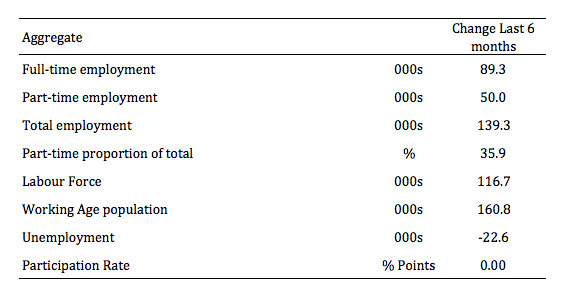

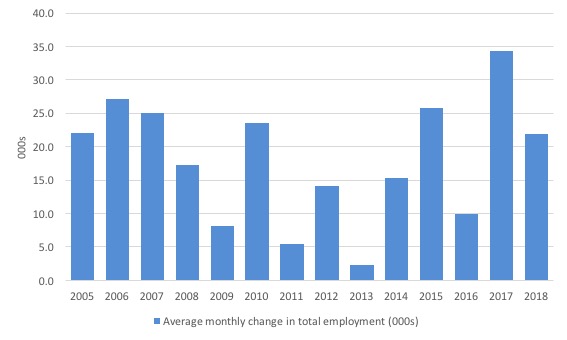
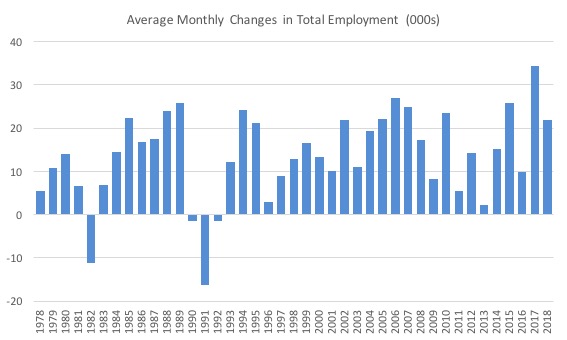
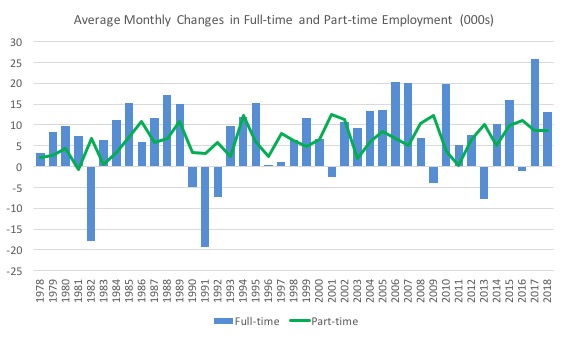


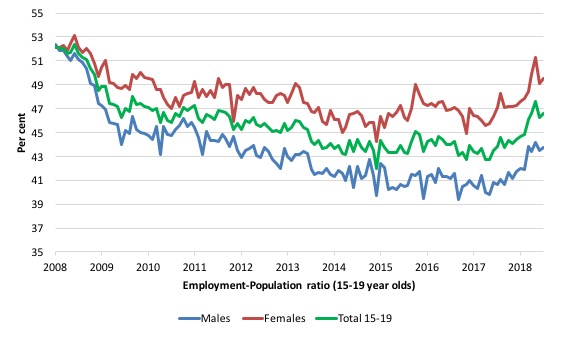



Ever since the ABS (quite a few years back!) cuts I have focused on the trend numbers for this series.